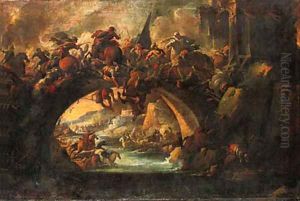Francesco Graziani, Called Ciccio Paintings
Francesco Graziani, better known by his nickname 'Ciccio', was an Italian Baroque painter born in 1604 in the town of Bastia Umbra, near Assisi. He was active primarily in the region of Umbria, where he developed his artistic skills and contributed to the rich tapestry of Italian Baroque art. Although not as widely known as some of his contemporaries, Graziani's work is appreciated for its dynamic compositions and vibrant use of color.
Ciccio began his artistic training under the guidance of his elder brother, the painter Cesare Graziani. He also worked with Giovanni Battista Michelini, further honing his craft. Throughout his career, Ciccio was influenced by the works of the leading painters of the time, such as Pietro da Cortona and the Carracci family. His style is characterized by energetic movement, expressive figures, and a strong narrative quality, which were hallmarks of the Baroque period.
Graziani's paintings often featured religious subjects, as was typical for the era, with a focus on dramatic biblical scenes and the lives of the saints. His works can be found in various churches and collections throughout Umbria and Rome. One of his notable works is the fresco in the apse of the Church of San Filippo Neri in Perugia, which showcases his ability to create an illusion of depth and space, a technique known as quadratura.
Despite his accomplishments, Graziani did not achieve the same level of fame as some of his contemporaries. However, his contributions to the Italian Baroque movement continue to be recognized by art historians and enthusiasts. He passed away in 1663, leaving behind a body of work that reflects the vibrancy and dynamism of Baroque art.
